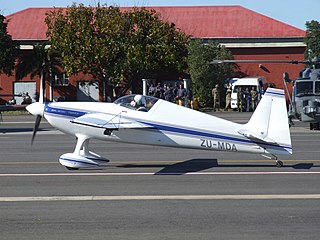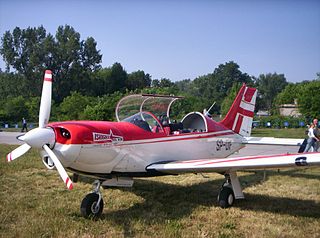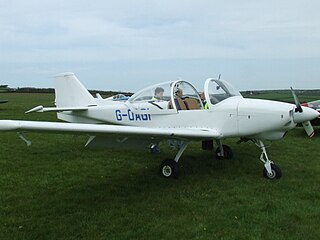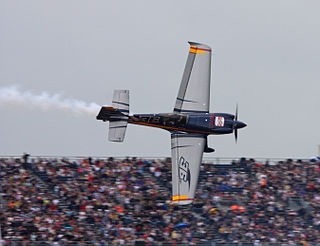
The Slick Aircraft Slick 360 is a South African aerobatics aircraft produced by the Slick Aircraft Company of Pretoria, South Africa. It is designed exclusively as an aerobatic competition aircraft, to compete in events such as the Advanced World Aerobatics Championships (AWAC).

The Zivko Edge 540 manufactured by Zivko Aeronautics is a highly aerobatic aircraft. Capable of a 420 degree per second roll rate and a 3,700 foot per minute climb rate, it has been flown to victory on the international Unlimited aerobatics circuit several times since the mid-1990s. A tandem-seat version is sold as the Edge 540T.

The Extra Flugzeugbau EA300 is a two-seat aerobatic monoplane capable of Unlimited category competition. It was designed in 1987 by Walter Extra, a German aerobatic pilot, and built by Extra Flugzeugbau.

The CAP Aviation CAP-23x family is a family of aircraft designed for competition aerobatics. The CAP 230 airframe was a direct development of the CAP 21 competition single seater strengthened to cope with a 300 hp (220 kW) 6-cylinder Lycoming AEIO-540 engine instead of the 200 hp (150 kW) original 4-cylinder Lycoming AEIO-360.

The Pitts Special is a series of light aerobatic biplanes designed by Curtis Pitts. It has accumulated many competition wins since its first flight in 1944. The Pitts biplanes dominated world aerobatic competition in the 1960s and 1970s and, even today, remain potent competition aircraft in the lower categories.

The Extra 200 is a two-seat, tandem arrangement, low-wing aerobatic monoplane with conventional (taildragger) landing gear fully capable of Unlimited category competition, built by Extra Flugzeugbau.

The Zlin Z-50 is an aerobatic sports airplane built by the Czechoslovakian company Zlin Aircraft.

The American Champion 8KCAB Decathlon and Super Decathlon are two-seat fixed conventional gear light airplanes designed for flight training and personal use and capable of sustaining aerobatic stresses between +6g and −5g. The Decathlon entered production in the United States in 1970 as a more powerful and stronger complement to the American Champion Citabria line of aircraft.

The Grob G 120 is a two-seat training and aerobatic low-wing aircraft with a carbon composite airframe, built by Grob Aircraft. It is based on the Grob G 115TA training aircraft and is specially designed for military and civil pilots training. It has a tricycle landing gear and a low tailplane.
Fajr F.3 is an Iranian full composite four-seat training/touring aircraft built by Fajr Aviation & Composites Industry. First flown in 1995, production commenced in 2001 after the aircraft was certified to JAR-23 standard. It has been speculated that it is a copy/modification of the Cirrus SR-20.

PZL M26 Iskierka or M26 Airwolf is a Polish trainer and aerobatic aircraft, designed at WSK PZL-Mielec.

The Mudry CAP 10 is a two-seat training aerobatic aircraft first built in 1970 and still in production in 2007. The plane was developed from the Piel Super Emeraude and was born as the CP100. The name changed to CAP 10, CAP for 'Constructions Aéronautiques Parisiennes'. The CAP 10 was manufactured by Mudry in Bernay, France, bought by CAP Industries which then became Apex Aircraft. Following the bankruptcy of Apex in 2008, rights to produce spares were awarded to Dyn'Aviation. After the bankruptcy of DynAero in 2012, manufacture of spares was taken over by CEAPR in Darois.

The AS/SA 202 Bravo is a two to three-seat civil light aircraft jointly designed and manufactured by the Swiss company Flug- und Fahrzeugwerke Altenrhein (FFA) and the Italian company Savoia-Marchetti. The aircraft was designated the AS 202 in Switzerland, and the SA 202 in Italy.

The Christen Eagle, which later became the Aviat Eagle in the mid-1990s, is an aerobatic sporting biplane aircraft that has been produced in the United States since the late 1970s.

The Extra 230 was a single-seat aerobatic aircraft developed in Germany in the early 1980s. Designed by aerobatic pilot Walter Extra based on the layout of the Laser 200 he was previously flying, the Extra 230 was a conventional mid-wing cantilever monoplane with fixed tailwheel undercarriage and a wire-braced empennage. The fuselage and empennage were of steel tube construction, but the wings were wooden. Production continued until 1990, at which time it was replaced by the Extra 300

The Sprint is a light aircraft developed in the United Kingdom in the 1980s, originally known as the Trago Mills SAH-1. It was produced by FLS Aerospace in two versions, the Club Sprint, and the Sprint 160. In both versions, it is a low wing, two seat, monoplane designed as an advanced aerobatic trainer with +6/-3 g capability. The aircraft is a fully aerobatic trainer similar to the Grob G 115 or the Slingsby Firefly, although it is of conventional riveted aluminium construction rather than the composite construction of the other two aircraft.

The MXS is a single-seat aerobatic aircraft made of carbon fiber and built by MX Aircraft Company, a manufacturer located at Jandakot Airport in Perth, Western Australia. The MXS-R is a race variant flown by several pilots in the Red Bull Air Race World Championship. The planes are all-composite in construction, piston-powered, low-wing monoplanes. They are produced both in kit form for amateur construction, and completed ready to fly at the factory.

The XtremeAir Sbach 342 (XA42) is a German high performance two-seat aerobatic and touring monoplane designed by Philipp Steinbach with Albert Mylius and built by XtremeAir GmbH of Hecklingen.

The Rihn DR-107 One Design is an American aerobatic homebuilt aircraft that was designed by Dan Rihn and first flown in 1993. The aircraft is supplied by Aircraft Spruce & Specialty of Corona, California in the form of plans and a materials kit for amateur construction.

The Game Composites GB1 GameBird is a British single-engine, two-seat, aerobatic aircraft that was designed by Philipp Steinbach and the first prototype was built by Game Composites.



















